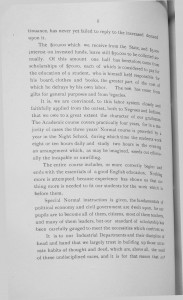Category: 2012 Presentations
Native American Experience
How did Native Americans experience the “Americanization” process at Hampton Institute and Carlisle Indian Industrial School from the 1870s to 1910?
The reformation of education for the Native American race was based on ideals of individualism, industry, and the acceptance of Christian doctrine and morality (Wallace Adams 15). The set of European values that were prevalent in American culture saw to it that the Native American race could never live in harmony due to Euro-centric hegemonic views. In the 19th century it became clear that the Native Americans would either face extermination or “civilization”. The term “to civilize” comes to represent the fact that no respect is given to the Indian American culture, values and traditions. If no mutual respect is achieved than is it possible to ingratiate the Native American subculture into the wider society that is America?
Today, Native Americans are one of the most under represented groups in the hierarchy of American culture. In the past they have been viewed as savages and lower level members of society. Attempts to educate the Indians were based on the ideals of assimilation or nothing at all. Policymakers never took into account that Native Americans had their own set of skills and intellect that they could bring to the table. In general, the system of mass education, not only Native Americans but for other immigrants has been based around deculturation and not ingratiation. This process is successful in creating a mostly unified nation but it fails to account for aspects of ethnic identity that cannot be drawn out and erased. The reason why Native Americans have done so poorly in decades following the 19th century is because the assimilation or Americanization process was in opposition to their culture so it was destined to fail.
Hampton University is a historically black college in Virginia. In 1885 its founders described it as “a school for freedmen, which gradually, under the care of the American Missionary Association, came to assume proportions which showed beyond question that situation, surroundings and opportunity had combined to make it one of the educational centres of the South.” The school began in 1868 as Hampton Normal. It started with 15 students and two teachers. In 1878, a party of seventeen Indians were brought from St. Augustine, Florida where they had been prisoners of war. This became the nucleus for the Indian Department at Hampton.
By 1885, the United States made a clear effort to try and educate the Native Americans. Hampton Institute reported “120 Indians are provided for by the United States Government.”
“For a majority of cases the three years’ Normal course is preceded by a year in the Night School, during which time the students work eight or ten hours daily and study two hours in the evening an arrangement which…weeds out effectually the incapable or unwilling.”
“The entire course includes, or more correctly begins and ends with the essentials of a good English education. Nothing more is attempted because experience has shown us that nothing is more needed to fit our students for the work which is before them.” (p. 8)
The course load focused on “the fundamentals of political economy and civil government”
Its important to look at the rhetoric that this writer uses when describe the education of Native Americans. “Will Indians study? Can they learn.” “Will Indians work? Can they be broken into civilized pursuits?”
In this time period the rhetoric used to describe the Native Americans was very disrespectful and it is representative of the negative perspective that the white American ideology had on Natives.
Armstrong, M F, Helen W. Ludlow, and Elaine G. Eastman. Hampton Institute: 1868 to 1885. Its Work for Two Races. Hampton, Va: Normal school press print, 1885. Print.
SAT changes
Question: How have colleges adjusted their opinions and requirements for standardized testing since 1984?
In 1984, Bates College made the decision to stop requiring applicants to submit their SAT scores in order to gain admission, deciding to instead judge students based on their academic performance, accomplishments within schools, and the qualities of their personality. Since then, over three hundred colleges and universities no longer require students to submit SAT or ACT when applying to college, and many of those do not require and kind of standardized testing to be submitted. The growing movement demonstrates that colleges no longer look at standardized testing with the same weight as they did before 1984 and instead focus on high school achievements and personality as bigger factors. This is a result of some schools losing faith in the SAT as an effective measure when comparing schools and no longer wanting standardized test scores to hold back qualified students. While the list of SAT optional schools mainly comprises of smaller liberal arts colleges who receive fewer applicants, some larger state schools have joined in this recent trend of making what used to be a major component of the application process into an optional part where students who feel that their standardized test scores could hurt their college matriculation no longer have to send their scores or take any standardized test including the SAT, ACT, and SAT subject tests. However, some schools still ask that students to submit SAT subject tests and AP exam scores, but this still leaves students with the option of submitting scores in subjects where they feel they can perform strongest. This list includes a number of schools ranked within the top 100 colleges and universities nationally and includes the entire NESCAC league and some larger colleges. Some of these colleges and universities will only consider standardized testing scores into their decisions when the GPA requirements are not met, or will only use those scores to determine placement and academic advising when a student has gained admittance. The purpose of the SAT and standardized testing is shifting to give students the largest possible advantage when applying to schools.
When a school becomes SAT optional it is with the intent to make a school more diverse and to give each student more attention when observing their application. Some defenders of the SAT suggest that schools will see a drop in academic quality if they continue to make the SAT an optional part of the admissions process and the College Board suggests that the movement should only pertain to vocational schools or schools that accept all of their applicants.

Bates decided to implement their policy in 1984 when they felt that students kept telling them that they were more intelligent than their standardized test scores would suggest, and it was their scores alone that were stopping them from going to a school that fit their academic potential. After the policy was implemented, one of the first students to benefit was a girl who had graduated as valedictorian from her high school and is now at Dartmouth Medical School. However, when she applied to Bates her combined SAT score was less than 1000. Since Bates never looked at these scores, she was admitted, and went on to graduate Phi Beta Kappa. The college has found that since their policy was implemented those who did not submit SAT scores during the admissions process have had nearly identical GPA’s and graduation results to those students who did submit their SAT scores.
DR Presentation
Ed 300 Presentation
Presentation- Hurricane Katrina
Research Presentation
Two-way Immersion
Kindergarten: The Changes from Play to Work
Question: “In the United States, how do the learning goals and curriculum for kindergarten classrooms differ from it’s adoption in the early 1900s to today? And why have they changed?
Thesis:
- In the early 1900s kindergarten’s curriculum encouraged play and natural development
- Reason: kids need a year to prepare for school, not ready for academic pressures
- Today, kindergarten’s curriculum encourages academic learning
- Reasons for the change: preschool has adopted the play-like curriculum, and because of the pressures from standardize testing and parents, kindergarten’s role has shifted to being academic-based instead
Sources:
Jen Scott Curwood: What Happened To Kindergarten
- why original model was implemented
- how kindergarten has changed
- why kindergarten has changed
- Interesting fact: a decade ago, only 15% of kindergartens could read. today in a county in Maryland, 90% of kindergartens could read
Presentation
Presentation – moody
Homeschooling Presentation
Question: what factors have caused an increase in elementary and secondary level homeschooling in the United States in recent years; and what demographic groups have become more attracted to this option over this period of time?
Thesis: Factors causing increased homeschooling religious and moral values, dissatisfaction with school academics and administration, safety concerns, travel distance, mobility, education of women, special needs, and internet communication.
Primary sources:
“Homeschooling in the USA: Past, Present and Future” (Milton Gaither)
“Why Homeschooling Happened” (Milton Gaither)
“Scholastic Achievement and Demographic Characteristics of Home School Students in 1998” (Lawrence Rudner)
Discussion:
Main reasons for homeschooling:
(1) Religious and moral concerns
(2) Dissatisfaction with public schooling (administration and teaching)
(3) Concern for safety
(4) Academic and social results good
Recent Changes:
(1) still mainly driven by religious/moral concerns and dissatisfaction
(academic results, lack of religion, sex education)
(2) Growing school violence
(3) More people joining (minorities now 23%; broader appeal)
(4) Internet increasing access to teaching and materials
Visual:
http://nces.ed.gov/pubs2006/homeschool/TableDisplay.asp?TablePath=TablesHTML/table_4.asp
Presentation on Teach for America
Trinity departments and programs
Quest to Racially Integrate:How Have Relations Between People of Color and Institutions of Higher Learning Changed Over Time?
https://docs.google.com/presentation/d/178bIXkPUinZgT2E4GVJ8k0jrBfSXU5d9UdH0Kvvd_MU/edit
hint from Jack: insert the URL above into a link to your presentation
Presentation Link
Presentation on Community College
Coeducation of Trinity College
The Effect of Student Social Movements on Trinity College Policy
To Teach Or Not To Teach
To Teach Or Not To Teach. A project examining the idea of “teaching to the test” and how NCLB has or hasn’t changed it.
Link to my presentation here
From Chalkboards to Smart Boards?
Q:Has teaching changed over the years, with the introduction of technology? Have interactive white boards changed the way teachers teach?
Thesis: It’s not clear whether teaching has changed over the years with the introduction of technology.
Sources:
-Larry Cuban’s books
1. “The Classroom Use of Technology since 1920”
2. “Oversold and Underused: Computers in the Classroom”


